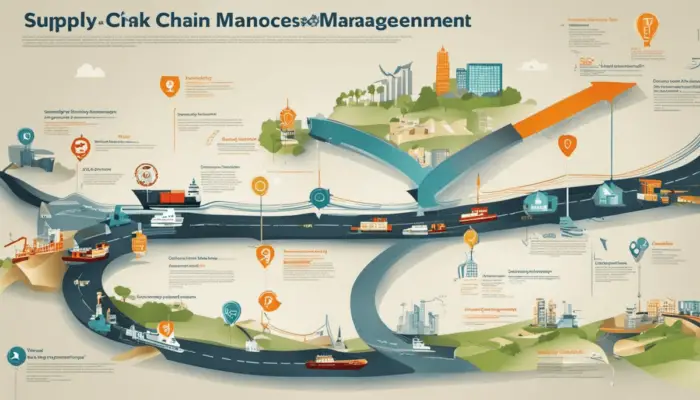Staying one step ahead in today’s competitive marketplace necessitates an in-depth understanding of various operational elements, among which supply chain risk management stands out significantly.
The dynamism and complexity of modern supply chains create multiple risk points that, if not adequately managed, could lead to severe financial and operational repercussions.
One unique tool businesses can employ to mitigate these adverse effects is insurance. Incorporating insurance into supply chain risk management allocates the risk of potential financial losses and ensures business continuity amidst unforeseen disruptions.
This article dives into the intertwining of supply chain risk management and insurance, illumining the significant roles, challenges, opportunities, and future trends in this strategic fusion.
Understanding Supply Chain Risk Management
Understanding Supply Chain Risk Management
Supply chain risk management refers to the coordination of activities to direct and control an organization’s supply chain with regard to potential risks.
These risks may originate from various sources, such as financial, operational, or external factors. Financial risks may include fluctuations in exchange rates or raw material prices.
Operational risks may arise from production disruptions, while external risks may occur due to natural disasters or terrorist activities.
As the world becomes more interconnected, supply chains are becoming increasingly complex, enhancing the potential for risks. Managing these risks is crucial to maintaining business continuity.
Managing supply chain risks efficiently can lead to significant financial losses, damaged reputations, and lost sales.
Risk Factors and Mitigation Strategies in Supply Chain Risk Management
Numerous factors can prompt risks within the supply chain. These risk factors, undoubtedly, are capable of causing significant damage to the company.
These include logistical issues, supplier solvency, quality control, transportation interruptions, and geopolitical issues.
To mitigate these risks, organizations need to develop robust strategies. These strategies can include diversifying supplier sources to reduce dependency on a single supplier and increasing transparency within the supply chain.
It also identifies and tackles potential risks promptly, investing in technology to enhance supply chain monitoring and predictive insights, and testing various scenarios to plan responses to potential disruptions.
The Role of Insurance in Supply Chain Risk Management
Insurance plays a pivotal role in supply chain risk management by providing a financial safeguard against various types of risks.
Business Interruption insurance, for example, covers lost income and expenses incurred when business operations are halted due to supply chain disruptions.
Additionally, Contingent Business Interruption insurance policies provide coverage for losses caused by disruptions in a supplier’s or customer’s operations.
On the other hand, trade disruption insurance compensates for losses due to political risks, such as government actions that prevent the execution of a contract.
Product recall insurance is another type of coverage that addresses the costs of recalling a product from the market.
Other types of specific insurance like cargo, credit risk, or cyber insurance, can cover more specific risks within the supply chain.
However, insurance should be considered part of a broader risk management approach rather than a standalone solution.
This approach should include risk assessment, mitigation strategies, and a well-tested response plan.
Understanding the Role of Insurance in Business Continuity
Implementing a strategic insurance plan can provide the financial bedrock that ensures the continuity of business operations amidst unexpected disturbances.
This financial support facilitates a quick company recovery following a crisis, which minimizes detrimental impacts on revenue and client relationships.
Uncertainty permeates every supply chain, but well-structured risk management, including a comprehensive insurance strategy, permits businesses to mitigate disruptions effectively.
Companies can transfer risks to a third party through insurance plans, providing a crucial buffer against possible supply chain interruptions.
Yet, triumph in supply chain risk management is predicated on the ability to foresee, prepare for, and proactively manage risks before they occur.
In short, while insurance is an integral risk mitigation tool, it isn’t a substitute for a well-executed risk management strategy.

Relationship between Insurance and Supply Chain Risk Management
The correlation between Insurance and Supply Chain Risk Management
The integral role of insurance coverage in executing successful supply chain risk management cannot be overstated.
It is one of the key strategies in risk management, where the financial losses that may arise from supply chain disruptions can be transferred to insurance providers.
Consequently, this not only safeguards the business’s financial health but also ensures its prolonged continuity.
Types of Insurance Covers for Supply Chain Risks
Numerous types of insurance can be applied to various supply chain risks. These include, but are not limited to:
- Business Interruption Insurance: This insurance covers income lost due to a disruption in the company’s operations. It could be due to various reasons, like natural disasters or unforeseen obstacles that obstruct the supply chain process.
- Contingent Business Interruption Insurance: Contingent business interruption (CBI) coverage occurs when a significant supplier or receiver of goods suffers from an insurable loss, like fire or vandalism, that prevents them from providing or receiving goods or services.
- Liability Insurance: Also known as general liability insurance, this type protects the company from claims related to bodily injury or property damage due to business operations.
- Product Recall Insurance: This insurance is designed to cover costs associated with recalling a product from the market, which may stem from a supply chain issue leading to design or manufacturing defects.
- Marine / Transit Insurance: This covers loss or damage of cargo while in transit from one place to another.
The Interplay of Insurance and Supply Chain Risk Management
The role of insurance in supply chain risk management is not merely to provide financial protection to the organization against potential losses.
It also enhances the robustness of the supply chain by identifying, analyzing, and mitigating potential risks before they materialize.
Insurance companies conduct risk assessments to identify vulnerable areas within a supply chain.
These assessments allow businesses to adopt precautionary measures to avoid potential disruptions and reduce the eventuality of making an insurance claim, thereby paving the way for operational and supply chain improvements.
Risk Transfer and Insurance
Risk transfer is essentially recognizing that risks may materialize at some point and having plans to pass those risks over to a third party better equipped to manage or absorb them, like an insurance company.
Insurance plays a crucial role in disbursing the risk associated with a particular supply chain by distributing it across multiple entities.
This process lessens the potential financial impact on a single entity, providing greater resilience and protection to the overall supply chain.
The Crucial Role of Insurance in Supply Chain Risk Management
Insurance plays a vital role in managing supply chain risks. Besides offering financial coverage, insurance also stimulates and facilitates a comprehensive and proactive manner of handling these risks.
The significance of insurance in supply chain risk management becomes more apparent with the occurrence of global, unpredictable catastrophes that can disrupt production and jeopardize companies.

Case Studies of Insurance in Supply Chain Risk Management
A Real-World Illustration: The Automotive Industry and the Tsunami in Japan
A great example of insurance playing a crucial role in supply chain risk management is witnessed in the automotive industry post the 2011 earthquake and tsunami that struck Japan.
Home to numerous vehicle manufacturing companies, this disaster led to a standstill in the production line, influencing manufacturers globally.
Major industry key players such as Toyota suffered significant disturbances in their production lines, owing to the scarcity of component supplies from the affected regions.
In response to the potential financial implosion, Toyota and other manufacturers utilized ‘Contingent Business Interruption insurance.
This policy covered the losses in profits and extra operating costs, enabling businesses to weather this tough phase.
Case Study 2: Nike’s Proactive Supply Chain Risk Management
Nike is another company that leveraged insurance in its supply chain risk management.
Recognizing its exposure to political unrest and natural disasters, Nike implemented a ‘Political Risk Insurance’ policy due to its reliance on overseas manufacturers, protecting them from financial losses resulting from political instability.
The company also utilized ‘Natural Catastrophe Insurance’ to safeguard against natural disasters, reducing downtime and mitigating financial risk.
Case Study 3: The Tech Industry and Intellectual Property Protection
In the tech industry, where intellectual property is essential, companies like Apple and Samsung have invested in ‘Intellectual Property Insurance.
This insurance policy provides financial coverage for losses resulting from lawsuits related to intellectual property rights, which can interrupt supply chain operations.
Given the competitive and litigious nature of the tech industry, such insurance policies act as a risk management tool that ensures sustained operations even in the face of legal disputes.
Case Study 4: Pharmaceutical Industry and Its Exposure to Regulatory Risks
Risks associated with regulatory changes and compliances are very real for pharmaceutical companies due to the critical nature of their products for public health.
For instance, regulatory changes or injunctions can halt the manufacturing or distribution process, causing severe disruptions in the supply chain. Companies such as Pfizer have adopted various insurance policies as risk management tools.
One of them is ‘Regulatory Change Insurance,’ which covers losses due to a sudden change in regulations. Additionally, ‘Product Recall Insurance’ is used to manage potential financial loss arising from a mandated recall of products.
In this article, we explore a variety of case studies that underscore the significance of insurance policies as intrinsic components in managing supply chain risks across diverse industrial landscapes.
The insurance necessary corresponds to the nature and extent of the risk in tandem with the unique operational structure of individual sectors within the supply chain.
Factors such as geographical positioning, political stability, and a region’s regulatory environment significantly influence the kind of insurance required.

Challenges and Opportunities in Applying Insurance to Supply Chain Risk Management
Delving into Supply Chain Risk and Insurance’s Role
The concept of supply chain risk encompasses any potential obstacle that may disrupt the steady flow of goods and services from the provider to the end user.
It includes risks associated with suppliers, transport modalities, storage facilities, or other chain elements.
In the face of these uncertainties, insurance serves as a safety net, delivering fiscal assurance against potential losses emanating from these disruptions.
The Challenges in Integrating Insurance into Supply Chain Risk Management
One significant challenge that businesses may encounter while integrating insurance into their supply chain risk management is the complexity and variability of risks involved.
This requires understanding various risk forms such as operational, financial, reputational, regulatory, or even geopolitical risk.
Examples include a supplier’s bankruptcy, regulatory changes, terrorism, and natural disasters.
The solution lies in developing a comprehensive understanding of the entire supply chain and identifying all potential risk points.
Another challenge is the cost associated with insurance. High-risk areas or materials may lead to more expensive premiums that may deter some companies from obtaining adequate coverage.
Carefully assessing the potential risks and comparing them against the insurance costs can provide a more accurate picture of the cost-benefit analysis.
Furthermore, obtaining appropriate coverage could be challenging. This is due to the fact that some insurance policies might not cover all types of supply chain risks.
For instance, traditional business interruption insurance might not cover disruptions caused by a key supplier’s failure.
One possible solution to this challenge is adopting a more comprehensive approach, such as supply chain insurance, which can cover a broader range of risks.
Uncovering the Potential of Insurance in Supply Chain Risk Management
In spite of existing hurdles, incorporating insurance within the context of supply chain risk management comes with numerous benefits.
At the forefront, insurance provides a financial safety net against unpredictable occurrences, such as costs linked to product loss or damage and penalties caused by late deliveries.
Also, expenses incurred from identifying a new supplier or establishing a new production route due to a supplier’s collapse.
Furthermore, certain insurance classifications may deliver comprehensive risk evaluations as a component of the underwriting procedure.
This offers a priceless objective review of a business’s supply chain threats, thus helping them refine their in-house risk management practices and bolster stakeholder confidence.
There are also scenarios involving drastic disruptions where a company is rendered incapable of meeting its delivery commitments.
In such instances, insurance can take the spotlight by preserving the financial footing and reputation of the company, enabling it to reassure its stakeholders about its robust risk management strategies and capability to tackle disruptions.
Insurance plays a crucial role for companies in cultivating trust and credibility with their stakeholders.
It instills confidence in investors, customers, and employees alike that the company is adequately safeguarded and well-prepared to overcome potential obstacles.
With this sense of security, businesses can aim for improved performance and long-term growth.

The Future of Insurance in Supply Chain Risk Management
Navigating Through Emerging Risks and Environmental Perils
The escalating intricacy of global supply chains has given rise to threats such as cyber intrusions, geopolitical volatility, and aspects associated with climate change.
In response to these evolving risks, insurers are devising resourceful products to manage and transfer these uncertainties.
Focusing on climate change specifically, insurers provide services like parametric insurance – a financial solution that initiates payouts when pre-set environmental indicators are surpassed.
This brings to light the critical role of insurance in mitigating supply chain risks.
Cybersecurity Risks in Supply Chain
Cybersecurity risk is one of the most significant emerging threats to global supply chains.
Hackers can disrupt software systems, halt production, and steal sensitive information, leading to significant economic loss and damage to brand reputation.
To mitigate these risks, insurers provide coverage such as cyber liability insurance, which covers the costs related to the loss or theft of data, network security breaches, and recovery of compromised systems.
Digitization and Predictive Analytics in Insurance
Predictive analytics, advanced data modeling, and digital transformation reshape insurance’s supply chain risk management role.
By using predictive analytics, insurance companies can identify potential risks in a supply chain by analyzing patterns in data generated from events in real time, helping businesses develop proactive strategies.
This form of predictive insight can help organizations adapt their strategies to manage potential risks better, thus reducing the likelihood of crisis.
Artificial Intelligence in Insurance
Artificial Intelligence (AI) technologies are altering the traditional insurance model too.
AI can aid in automating various aspects of the insurance process, from risk assessment to claims processing, thereby improving accuracy and reducing overall administrative burdens.
AI can also help understand complex supply chain networks, identify vulnerabilities, and suggest improvements, thus playing a critical role in risk mitigation and management.
Blockchain Technologies and their Role in Insurance
Blockchain technology offers new ways to manage supply chain risks and streamline insurance processes.
Smart contracts powered by blockchains can automate claims and payouts, improving transparency and trust among parties.
Further, real-time tracking of goods across the supply chain through blockchain enhances traceability, helping insurers, and businesses monitor the movement, status, and conditions of goods, thereby detecting and managing risks sooner.
Impact of Digital Transformation on Supply Chain Risk Management
Digital technologies are significantly transforming supply chain management and will likely shape the future of risk management and insurance.
They allow for greater transparency, improved efficiency, and increased supply chain resilience while also opening up innovative ways for insurers to handle risks.
However, companies must simultaneously address new risks such as cyber vulnerabilities that emerge from increased digitization.
The role of insurance will continue to evolve as companies and insurers explore ways to proactively leverage technology to manage and mitigate risks in their supply chains.

Conclusion
The current trajectory of our global landscape, marked by the risks of cyber-security threats, climate change phenomena, and an over-arching digital revolution, will invariably impact businesses and their supply chain management operations.
Adapting to these shifts will be crucial, and insurance, in all its evolving forms and covers, stands in the front line of enabling businesses to manage these risks better.
Through the integration of innovative technology solutions such as AI, predictive analytics, and blockchain, the process of identifying, assessing, and managing supply chain risks becomes more precise and optimized.
When thoughtfully integrated and leveraged, insurance in supply chain risk management can play a pivotal role in driving operational efficiency, enhancing resilience, and ultimately, ensuring business sustainability and growth in an ever-evolving, risk-laden business landscape.

Chris Ekai is a Risk Management expert with over 10 years of experience in the field. He has a Master’s(MSc) degree in Risk Management from University of Portsmouth and is a CPA and Finance professional. He currently works as a Content Manager at Risk Publishing, writing about Enterprise Risk Management, Business Continuity Management and Project Management.

